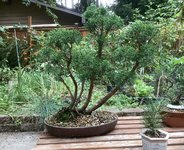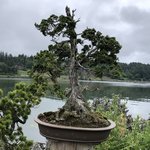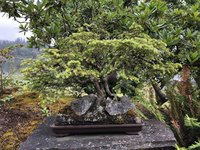Deep Sea Diver
Masterpiece
Recently I was at risk of hijacking a thread on “What’s the best fertilizer?” it seemed to me that was yet another one of those discussions where no one will sail away with a totally convincing argument for one of the other type of fertilizer. There simply can’t be and I believe there is a reason for this…
From my perspective, there is a use for each type of fertilizer when growing bonsai, particularly when one considers the different emphasizes needed to grow out stock, bonsai in development and bonsai in refinement, let alone the thought of where the tree is located, what tree(s) are we talking about, what’s the media and environment inside and outside the pot…and the depth/type of the pot.
There is no exact answer. There does seem to be lots of different rationales for what folks think is “best“ though….
The whole point, IMHO, centers on the question , “What are the best ways to create sustainable conditions in which bonsai trees will thrive?”
I‘ve spent a good deal of time studying plants in pots from the PAC Bonsai Museum, Elandan Gardens, nurseries and everywhere else I can get to. Folks who know can make trees grow. Yet are these really healthy? To me the real salient question is, “What are all the key elements needed to make a tree robust and resilient so it can withstand the rigors of living in a pot?”
@Walter Pall actually took a stab at this by putting forth what I call the Walter Paul Triangle…. In this discussion he discussed the interconnection between Media, Fertilizer and Watering. That is a good starting point to answer this key question….
In my backyard it seems the trees with the most robust growth and are the most resilient to latest vagaries of the weather gods are those that have a healthy ecosystem in the pots… what that looks like depends on a lot of things.
So I would put forth that in this thread all replies should honestly attempt to provide answers the elements of this question…. Which I hope will help many of use move our bonsai thinking forward a notch…
1. “Which of these trees, in your opinion actually appears to be in a sustainable condition?….
2. ”Why is this so?” and finally,
3. “How, in your opinion, does one create the conditions to get their trees to this level of sustainability?”
No off handed replies folks, or snarky comments please. This is a serious question.
New folks are most welcome to participate.
You can answer all questions about one, two, three or all four of the examples below. These are not a trick questions.
A. Japanese Red Pine

B. Paul’s Scarlet Hawthorne

C. Satsuki azalea

D. Juniper Raft

cheers
DSD sends
From my perspective, there is a use for each type of fertilizer when growing bonsai, particularly when one considers the different emphasizes needed to grow out stock, bonsai in development and bonsai in refinement, let alone the thought of where the tree is located, what tree(s) are we talking about, what’s the media and environment inside and outside the pot…and the depth/type of the pot.
There is no exact answer. There does seem to be lots of different rationales for what folks think is “best“ though….
The whole point, IMHO, centers on the question , “What are the best ways to create sustainable conditions in which bonsai trees will thrive?”
I‘ve spent a good deal of time studying plants in pots from the PAC Bonsai Museum, Elandan Gardens, nurseries and everywhere else I can get to. Folks who know can make trees grow. Yet are these really healthy? To me the real salient question is, “What are all the key elements needed to make a tree robust and resilient so it can withstand the rigors of living in a pot?”
@Walter Pall actually took a stab at this by putting forth what I call the Walter Paul Triangle…. In this discussion he discussed the interconnection between Media, Fertilizer and Watering. That is a good starting point to answer this key question….
In my backyard it seems the trees with the most robust growth and are the most resilient to latest vagaries of the weather gods are those that have a healthy ecosystem in the pots… what that looks like depends on a lot of things.
So I would put forth that in this thread all replies should honestly attempt to provide answers the elements of this question…. Which I hope will help many of use move our bonsai thinking forward a notch…
1. “Which of these trees, in your opinion actually appears to be in a sustainable condition?….
2. ”Why is this so?” and finally,
3. “How, in your opinion, does one create the conditions to get their trees to this level of sustainability?”
No off handed replies folks, or snarky comments please. This is a serious question.
New folks are most welcome to participate.
You can answer all questions about one, two, three or all four of the examples below. These are not a trick questions.
A. Japanese Red Pine

B. Paul’s Scarlet Hawthorne

C. Satsuki azalea

D. Juniper Raft

cheers
DSD sends






